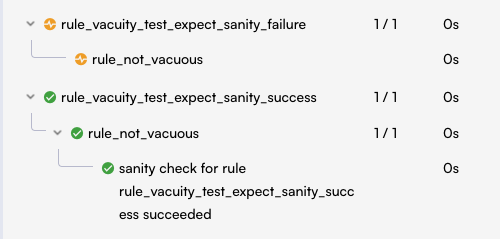Rule Sanity Checks (Solana)
The rule_sanity option enables automatic checks that warn about potential problems in the specification. Currently the only supported sanity check is the one called vacuity.
Note
This is the documentation for the sanity checks for Solana. If you are looking for the Sanity checks for Solidity, please refer to this section.
The --rule_sanity option can be set to none or basic and controls whether the sanity checks should be executed:
With
--rule_sanity noneor without passing--rule_sanity, no sanity check is performed.With
--rule_sanity basicor simply--rule_sanitywithout a mode, the sanity checks are executed.
Each sanity check adds a new child node to every rule in the rule tree of the
rule report. Each check transforms the the original program into a variant where
cvlr_satisfy!(true) is inserted at the end of the program, and all calls to
cvlr_assert are removed.
If the sanity check fails on a rule, the sanity node in the rule
report is displayed as a yellow icon, and its status propagates to the
parent rule’s node (see below for an example).
The remainder of this document describes the vacuity check in detail.
Vacuity checks
The vacuity sanity check ensures that even when ignoring all the
user-provided assertions, the end of the rule is reachable. This check ensures
that the combination of cvlr_assume! statements and implicit panics are not
contradictory. Rules that are satisfied due to contradictory assumptions are
called vacuous. Since vacuous rules do not actually check any
assertion, they are almost certainly incorrect.
For example, the following rule is vacuous (and is flagged by the vacuity check):
#[rule]
pub fn rule_vacuity_test_expect_sanity_failure() {
let amount: u64 = nondet();
cvlr_assume!(amount >= 2);
cvlr_assume!(amount <= 1);
cvlr_assert!(amount == 1);
// Expect a sanity failure here as the assumptions are conflicting
}
Since the two assumes amount >= 2 and amount <= 1 contradict each other, this rule
always passes, regardless of the content of the assertion. This is an
example of a vacuous rule — one that passes only because the
preconditions are contradictory.
In the rule report, a vacuity check adds a node called rule_not_vacuous_cvlr
to each rule. For example, see how the rule
rule_vacuity_test_expect_sanity_failure from above is reported as failing
sanity, as rule_not_vacuous_cvlr fails. Below you see an example of a rule
without the contradicting assumes that does not fail vacuity.
